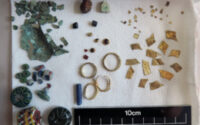What’s on : Lectures
Event Information
Dr Tania Dickinson, Honorary Fellow and formerly Senior Lecturer, Department of Archaeology, University of York
The ‘Acomb area’ assemblage is an unexpected chance find, recently acquired under the terms of The Treasure Act 1996 by the Yorkshire Museum. It consists of fragments from a gold-and-garnet decorated composite disc brooch and a dozen beads dating from the seventh century AD, the early Anglo-Saxon or, in Yorkshire, the Anglian period. The talk will recount how and how far it has been possible to recover the original appearance of the brooch and to place the assemblage in its original context – almost certainly a rich female burial. In so doing, it will illustrate processes and problems of acquiring archaeological and historical knowledge from artefacts, especially chance finds.
Lecture to be held in the Tempest Anderson Lecture Theatre, Yorkshire Museum,
YO1 7DR at 2.30pm
ALL WELCOME.
Image caption: The ‘Acomb area’ assemblage (YORYM: 2018.153). © York Museums Trust.
Member’s report
The chance discovery of fragments of jewellery in May 2016 by someone digging a post-hole in a garden in Acomb was reported to the Yorkshire Museum by its finder three day’s later. This was the beginning of an archaeological detective story which the chief investigating officer, Dr Tania Dickinson, recounted to the society in her lecture. The usual questions about fragmentary remains were raised: how was the object made? who supplied and distributed it? what was it used for, and did it change use or get repaired? When and where was it discarded? And, finally, what were the circumstances of its discovery? All of these questions need answering before any judgment can be made about the significance, aesthetic or intellectual, of the remains.
Dr Dickinson’s story began with the discovery. A hasty return to the scene of the find revealed that the concrete post had been put in place, disturbing the context of the find, but some excavation around the post did uncover a further small piece of garnet and some pottery shards. The assemblage therefore incorporated some tiny fragments of filigree gold panels, filigree wire fragments, some copper alloy, some cloisonné work, and some garnet pieces, which were accompanied by a dozen beads, of which two were annular. Scientific analysis revealed the materials to come from the 7th century, and the shape of the panels indicated that the find incorporated a circular brooch of inlaid garnets, probably belonging to a female of high status, along with the beads. Were these items part of a cremation burial, which was the case with similar finds elsewhere in England? The context of the find provided no help on this, but it seemed the likeliest line of enquiry. The brooch could be related to twenty similar finds in England, but stood out from them in being 150 miles further north than all save one, and the beads were similar in style, incorporating filigree inlay, to some found at two other sites in North Yorkshire, one on the coast and the other at Hawnby. The use of copper alloy suggested a date between 630 and 680.
But why Acomb, and why the North? The find was on an elevated site in Acomb and close to the Roman road leading from York to Aldbrough where it crosses another east-west ridge, a location which might attract a high-status burial for commemoration or even veneration. Which brings us to Christianity. The dating suggests links with the early arrival of Chrisitianity in the north following the baptism of King Edwin in 627, and the work on the Minster at York in 633-4 by King Oswald and its revival between 669 and 678 by Bishop Wilfrid. So, do we have the burial of a high-status female linked to the arrival of Christianity in the region, even perhaps with St Everilda, follower of Wifrid? After this detailed reconstruction our investigating officer was left with the problem about the hearsay nature of the reporting of the find and the lack of surrounding context at the identified site, so that when put before a judge the Scottish verdict of ‘not proven’ was the only one available.
All in all a fascinating insight into the work of the archaeologist elegantly described by Dr Dickinson, who invited her hearers to examine the assemblage now on display in the museum below.
Bill Sheils

